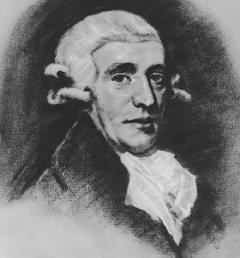 Joseph Haydn
Joseph Haydn Joseph Haydn
Joseph Haydn


Haydn og Mozart bliver ofte nævnt i samme åndedrag. I deres musik har de da også gensidigt inspireret hinanden, men i deres liv var de modsætninger. Mozart blev født i en gennemmusikalsk familie og blev allerede som barn tiljublet som et geni af fyrster og adelige. Til gengæld døde han glemt og forgældet.
Franz Joseph Haydn blev født i 1732, 24 år før Mozart, som søn af en karetmager, og trods et uomtvisteligt musikalsk talent måtte han i sine unge dage hutle sig igennem som akkompagnatør og kammertjener. Først i 1761 fik han et rimeligt levebrød, da han blev ansat som kapelmester hos den musikglade fyrst Esterházy med ansvar for dennes musikere og sangere. Om sommeren gjorde han tjeneste på fyrstens pragtslot i Eisenstadt, om vinteren i palæet i Wien. Han forblev i tjenesten i næsten 30 år indtil fyrsten døde, og hans efterfølger opløste kapellet.
Oratoriet Skabelsen fik sin første opførelse i Wien i april 1798, og det blev en overvældende succes. Få år senere blev værket opført overalt i Europa. Skabelsen er blevet opført flere gange af Akademisk Kor, senest i maj 1998.
Haydn tilbragte sine sidste år som en velhavende mand i Wien. Han var nu Europas kendteste komponist og blev overdynget med hædersbevisninger. Med årene svigtede kræfterne og den sidste koncert, han overværede, var i marts 1808 en opførelse af Skabelsen, dirigeret af Mozarts påståede banemand Salieri. Han døde en fredelig død i hjemmet i Wien i 1809, 18 år efter Mozart. Ved sørgemessen opførtes Mozarts Requiem.
Born in Rohrau, Austria in 1732 (the same year as George Washington) to a peasant family, Franz Joseph Haydn showed musical talent at an early age. He studied music with a relative, Johann Franck, and was playing the violin and organ - and singing in the church choir - by the time he was six. When he was eight, he was recruited by the St. Stephen's Cathedral in Vienna to sing in their choir. In Vienna, he continued to study violin and voice, and began to teach himself the rudiments of composition. When his voice broke at seventeen, he was kicked out of the choir, and he began to teach the clavier and play with street musicians for his daily bread. So great was his facility on the keyboard that he started to teach, all the while continuing his self-structured education in composition. His progress was rapid, and in 1759, he was appointed Chapelmaster and Composer to the court of the Bohemian Count Morzin. His first symphonies were composed for the orchestra of that court.
In 1761 - amidst a disappointing marriage - Haydn was appointed Music Director to Prince Esterhazy, a Hungarian nobleman; he was to remain in this job for three decades, composing for court ensembles, training singers, and generally improving the court's musical standards. His reputation as a composer - fueled by the popular success of his numerous symphonies, among other works - spread all over Europe, and upon the death of his second Esterhazy employer, he moved to Vienna, where he befriended Mozart and taught composition to the young Ludwig van Beethoven. Several trips to England followed, and his symphonies were lauded there as much as they had been on the continent. Following the popular taste, he began to write oratorios and masses. He died, at the age of 1809, an esteemed father of the Classical style.
Haydn is well-known for his symphonies, which number 104 in total; perhaps more significant, however, was his work in chamber music. He is generally considered to be the father of the modern string quartet; the 84 quartets he created are masterpieces of structure and craft, and laid the groundwork for the works of Mozart and Beethoven which were to follow later in the Classical period. He developed the quartet form from the existing divertimento to a mature genre, according each instrument an equal, sophisticated voice and imbuing the form with substance, architecture and grace. His quartets were inspirations for other composers - Mozart often referred to Haydn's work as the standard by which all chamber music was measured. Haydn's masses and oratorios, although not as oft-played as his instrumental ensemble works, are equally stunning in their craft.
|
Oprettet: 02-05-1998. Opdateret: 29-01-2006 af Werner Knudsen |